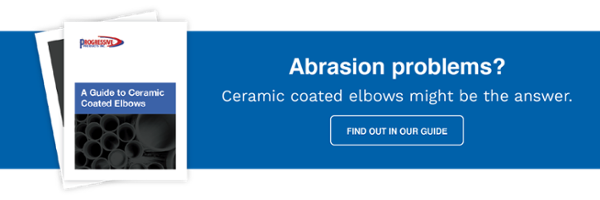Wear is one of the most common problems in pneumatic conveying, and it’s especially hard on the conveying elbows in your system.
Elbow wear can cause issues such as:
- Shredding
- Streamers
- Blocking and dusting
- Pile and bulking
- Contamination
- Downtime
- Friability
- Corrosion
- Erosion
And that’s to say nothing of the associated costs. That’s why you should be using durable, cost-effective, wear-resistant pneumatic conveying elbows.
There are a few different types of elbow wear that are the most common. It’s important to recognize them so that you can take steps to reduce the amount of wear you put on your system.
Impact Wear
What is it?
The most common type of wear on pneumatic conveying elbows is impact wear. Because pneumatic conveying elbows are where materials in your line change direction, they take the full brunt of that sudden force in the form of impacts. Over time, these impacts add up and will eventually punch a hole in even the thickest pneumatic conveying elbow.
Think of a metal playground slide. Imagine if you were to slam a small rubber ball at the end of it over and over and over again. It wouldn’t take long to dent and damage it. That’s impact wear.
How to Spot it
You will find impact holes either at or near the tangential line where the material hits the back of the pneumatic conveying elbow. Longer lines have more velocity and deal more damage to their joined pneumatic conveying elbows over time, making this a good place to look when you suspect impact wear.
Sliding Abrasion
What is it?
Sliding abrasion occurs when the materials in your system rub against other materials and wear the line components down over time. Several factors can impact how fast and severe sliding abrasion can be:
- The type of material used
- The velocity of the particles
- The air pressure in the system
- The particles' direction
Think of the playground slide again. Imagine rolling your small rubber ball down from the top this time. It doesn’t do much, does it? But if you were to repeatedly roll thousands upon thousands of balls down the slide for a year? Eventually, the side would show signs of wear where the balls slid. And that’s sliding abrasion.
How to Spot it
They appear as lines of abrasion that have a long, even pattern. If you find these under your couplings, you may need to use longer tangents or flanges.
Corrosion
What is it?
Corrosion occurs when the material you’re conveying is corrosive and slowly weakens the system over time. We don’t come across it often at Progressive Products, but when we do, it’s usually because of conveying chemicals. We saw an unusual example with oak chips once. A company was conveying oak chips, but the sap produced by the wood was corrosive and weakened their regular steel pneumatic conveying elbows.
How to Spot it
If you notice discoloration or rust somewhere in your system, you might have corrosion. In cases like that, you should probably be using a stainless steel pneumatic conveying elbow instead of a standard steel pneumatic conveying elbow or ceramic and ceramic lined ones.
Okay, imagine that slide one last time. This time, imagine it’s an all-metal slide from the 1950s. It’s old, and decades of rain and disuse have rusted it entirely, making it dangerous to use. That’s corrosion.
Don’t Let Small Problems Turn Big
Impact wear, sliding abrasion, and corrosion can all shorten the lifespan of your pneumatic conveying elbows and become troublesome and costly to fix. But knowing the signs to watch out for and which pneumatic conveying elbows to use are the first steps in preventing expensive problems later down the line.
At Progressive Products, we won’t sell you anything you don’t need, and we’ll get you the best pneumatic conveying elbow that’s right for your system. Contact us today and find the solution that’s right for you.


